Samara, Russia
| Samara (English) Самара (Russian) |
|
|---|---|
| — Inhabited locality — | |
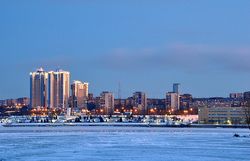 |
|
.svg.png) Location of Samara Oblast in Russia |
|
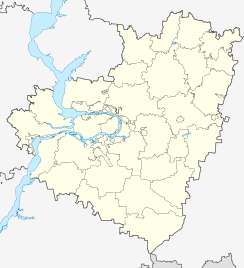 Samara
|
|
| Coordinates: | |
.png) |
.png) |
| Administrative status | |
| Country | Russia |
| Federal subject | Samara Oblast |
| Administrative center of | Samara Oblast |
| Municipal status | |
| Mayor | Viktor Tarkhov |
| Representative body | Samara City Council |
| Statistics | |
| Area | 465.97 km2 (179.91 sq mi) |
| Population (2002 Census) | 1,157,880 inhabitants[1] |
| - Rank | 6th |
| - Density | 2,485 /km2 (6,440 /sq mi)[2] |
| Time zone | MSK/MSD (UTC+3/+4)[3] |
| Founded | 1586 |
| Postal code(s) | 443XXX |
| Dialing code(s) | +7 846 |
| Official website | |
Samara (Russian: Сама́ра), called Kuybyshev (Ку́йбышев) from 1935 to 1990, is one of the largest cities in Russia. It is situated in the southeastern part of European Russia, the Volga Federal District, at the confluence of the Volga and Samara Rivers. Samara is also the administrative center of Samara Oblast. Population: 1,157,880 (2002 Census);[1] 1,254,460 (1989 Census).[4]. The metropolitan area of Samara-Tolyatti-Syzran within Samara Oblast constitutes the population of more than 3.0 million people. Formerly a closed city, Samara is now a large and important social, political, economic, industrial and cultural center of European Russia, which in May 2007 played host to the European Union—Russia Summit.
Samara is located on the east bank of the Volga river, which acts as its western boundary. Its northern boundary is formed by the Sokolyi Hills and by the Steppes in the south and east. The land within the city boundaries covers 46,597 ha. Samara has a continental climate characterized by hot summers and cold winters.
The life of Samara's citizens has always been intrinsically linked to the Volga river, which has not only served as the main commercial thoroughfare of Russia throughout several centuries, but also has great visual appeal. Samara's river-front is one of the favorite recreation places for local citizens and tourists. After the Soviet novelist Vasily Aksyonov visited Samara, he remarked: "I am not sure where in the West one can find such a long and beautiful embankment. Possibly only around Lake Geneva".
Samara is a leading industrial center in the Volga Area, and is among the top ten Russian cities in terms of national income and industrial volume. Samara is known for the production of aerospace launch vehicles, satellites and various space services, engines and cables, aircraft and rolled aluminum, block-module power stations; refining, chemical and cryogenic products; gas-pumping units; bearings of different sizes, drilling bits; automated electrical equipment; airfield equipment; truck-mounted cranes; construction materials; chocolates made by the Russia Chocolate Factory; Rodnik vodka; Zhiguli beer; food processing and light industrial products.[5]
Contents |
History
Early history
Legend has it that Alexius, Metropolitan of Moscow, later Patron Saint of Samara, visited the site of the city in 1357 and predicted that a great town would be erected there, and that the town would never be ravaged. The Volga port of Samara appears on Italian maps of the 14th century. Before 1586 the Samara Bend was a pirate nest. Lookouts would spot an oncomming boat and quickly cross to the other side of the peninsula where the pirates would organize an attack. Officially the town started with a fortress 1586 at the confluence of the Volga and Samara Rivers. This fortress was a frontier post protecting the then easternmost boundaries of Russia from forays of nomads. A local customs office was established in 1600.
As more and more ships pulled into Samara's port, the town turned into the center for diplomatic and economic links between Russia and the East. Samara also opened its gates to peasant war rebels headed by Stepan Razin and Yemelyan Pugachyov, welcoming them with traditional Bread-and-Salt. The town was visited by Peter the Great, all the Tsars Alexander, and Nicholas II.
In 1780 Samara was turned into the chief town (uyezd) of the Simbirsk Region overseen by the local Governor-General, and Uyezd and Zemstvo Courts of Justice and a Board of Treasury were established. On January 1, 1851 Samara became the center of the Province of Samara with an estimated population of 20,000. This gave a stimulus to the development of the economic, political and cultural life of the community. In 1877, during the Russian-Turkish war, a mission from the Samara city government Duma led by Pyotr V. Alabin, as a symbol of spiritual solidarity, brought a banner tailored in Samara pierced with bullets and saturated with the blood of both Russians and Bulgarians, to Bulgaria, which has become a symbol of Russian-Bulgarian friendship.
The quick growth of Samara's economy in the late 19th and early 20th centuries was determined by the scope of the bread trade and flour milling business. The Samara Brewery came into being in the 1880s, as well as the Kenitser Macaroni Factory, an ironworks, a confectionery factory and a factory producing matches. The town acquired a number of magnificent private residences and administrative buildings. The Trading Houses of the Subbotins, Kurlins, Shikhobalovs and Smirnovs—founders of the flour milling industry, who contributed a lot to the development of the city—were widely known not only across Russia, but also internationally wherever Samara's wheat was exported. In its rapid growth Samara resembled many young North-American cities, and contemporaries coined the names "Russian New Orleans" and "Russian Chicago" for the city.
By the start of the 20th century the population of the town had reached more than 100,000, and it was the major trading and industrial center of the Volga Area. During the Russian Revolution Samara was seized by the Bolsheviks in 1917. However on 8 June 1918, with the armed support of the Czechoslovak Legion, the town was taken by the Committee of Members of the Constituent Assembly or Komuch. They organised a "Democratic Counter-revolution", which at its height encompassed 12 million people. They fought under the Red Flag against the Bolsheviks. On 7 October 1918 Samara fell to the Fourth Army of the Red Army.
Soviet period
1921 was a year of severe hunger in Samara. To provide support to the people, Fridtjof Nansen (the famous polar explorer), M. Andersen-Nexø (a Danish writer), the Swedish Red Cross Mission, and officers of the APA from the United States came to Samara. Samara was renamed Kuybyshev in the honour of the Bolshevik leader Valerian Kuybyshev in 1935.
During the Second World War, Kuybyshev was chosen to be the capital of the USSR should Moscow fall to the invading Germans. In October 1941, the Communist Party and governmental organizations, diplomatic missions of foreign countries, leading cultural establishments and their staff were evacuated to the city.[6] A dug-out for Stalin known as "Stalin's Bunker" was constructed but never used.
As a leading industrial center, Kuybyshev played a major role in arming the USSR. From the very first months of World War II the town supplied the front with aircraft, firearms and ammunition. The famous military parade of 7 November 1941 was held on the central square of the town. On 5 March 1942, Shostakovich's Seventh Symphony was first performed in the town's Opera and Ballet House by the Bolshoi Theater Orchestra conducted by S.A. Samosud. The symphony was broadcast all over the world. Health centers and most of the city's hospital facilities were turned into base hospitals. Polish and Czechoslovakian military units were formed in the territory of Volga Military District. Samara's citizens also fought at the front, many of them volunteering to do so.
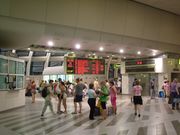
Kuybyshev remained the alternative capital of the Soviet Union until the summer of 1943, when everything was moved back to Moscow.
WWII would also see most of the area’s 1.5 million Germans dispersed when a reactionary movement sent most of them into exile or to forced-labor camps.
After the war the defense industry developed rapidly in Kuybyshev; existing facilities changed their profile and new factories were built, leading to Kuybyshev becoming a closed city. In 1960 Kuybyshev became the missile shield center for the country. The launch vehicle Vostok, which delivered the first manned spaceship to orbit, was built at the Samara Progress Plant. Yury Gagarin, the first man into space on 12 April 1961, took a rest in Kuybyshev after the landing. He first spoke to an improvised meeting of Progress workers. Kuybyshev enterprises played a leading hand in the development of domestic aviation and the implementation of the Soviet space programs. There is also an unusual monument situated in Samara commemorating the Ilyushin Il-2 ground-attack aircraft assembled by Kuibyshev workers in late 1942. This particular plane was damaged in 1943 over Karelia, but the heavily wounded pilot, K. Kotlyarovsky, managed to crash-land the plane near Lake Oriyarvi. The aircraft returned home in 1975. It was placed at the intersection of two major roads as a symbol of the deeds of home front servicemen and air-force pilots during the Great Patriotic War (World War II).
Post-Soviet period
In January 1991 the historical name of Samara was given back to the city. At the dawn of the 21st century Samara has become one of the major industrial cities of Russia with a powerful cultural heritage, multi-ethnic population and esteemed history.[5] Nowadays Samara is not a closed city any longer. Tourists from all over the world visit the place, attracted by the beautiful scenery and the mighty Volga. Foreign businessman live and work in Samara due to the great number of international companies and plants.
Culture
Samara has an opera and ballet theater, a philharmonic orchestra hall, and five drama theaters.[7]. There is a museum of natural history and local history studies, a city art museum and a number of cinemas.
The 20th Russian writer Alexey Tolstoy lived in Samara, and there is a museum dedicated to him. Dimitri Shostakovich lived in Samara during World War II and wrote his Seventh Symphony there.
There is a zoo and a circus in the city.
Education
Samara has 188 schools of general education, lyceums, high schools and the college of continuous education (from elementary up to higher education) known as Nayanova University existing under the aegis of International Parliament for Security and Peace attached to UNO. Samara is a major educational and scientific center of the Volga area. Twelve public and 13 commercial institutions of higher education as well as 26 colleges train future physicists and mathematicians, pedagogues and medical doctors, musicians and actors, directors and artists, aircraft- and missile-producers, journalists and lawyers, economists and architects, oil industry workers and mechanical engineers, archaeologists and electronic engineers, metallurgists and railroaders, telecommunication workers and interpreters and a lot of others. Samara is the home of Samara State Aerospace University (SSAU), one of Russia’s leading engineering and technical institutions. SSAU faculty and graduates have played a significant role in Russia’s space program since its conception. Samara is also the hometown of Samara State University, a prestigious higher-education institution in European Russia with competitive programs in Law, Sociology, and English Philology. Scientific research is also carried out in Samara. The Samara Research Center of the Russian Academy of Sciences incorporates the Samara branch of the Physical Institute, Theoretical Engineering Institute and Image Processing Systems Institute. Major research institutions operate in the city.[5]
Sports
Samara is the home to the FC Krylia Sovetov Samara, a football club in the Russian Premier League. Samara was also the home to the world women's basketball club VBM-SGAU. Before the 2007 season, the VBM-SGAU was sold to CSKA which moved the team to Moscow, where it became the CSKA[8]. The men's basketball club BC Krasnye Krylya Samara plays in the Russian Basketball Super League. The bandy team "ЦСК ВВС" plays in the 2nd highest division.[9] Samara is also home to Semyon Varlamov of the NHL's Washington Capitals, as well as young up and coming tennis player Anastasiya Pavlyuchenkova.
Transport
Samara is a major transport hub.
Kurumoch International Airport handles flights throughout Russia, Central Asia and to Frankfurt and Prague.
There are rail links to Moscow and other major Russian cities. The new unusually looking railway station building was completed in 2008.
Samara is a major river port.
Samara is located on the M5 Highway, a major road between Moscow and the Ural region.
City transport includes the Samara Metro, trams, municipal and private bus lines, and trolleybuses. Local trains serve the suburbs.
Honors
The asteroid 26922 Samara was named in honour of the city and river on 1 June 2007.†
Climate
| Climate data for Samara | |||||||||||||
|---|---|---|---|---|---|---|---|---|---|---|---|---|---|
| Month | Jan | Feb | Mar | Apr | May | Jun | Jul | Aug | Sep | Oct | Nov | Dec | Year |
| Source: Pogoda.ru.net[10] | |||||||||||||
International relations
Twin towns — Sister cities
Samara, Russia is twinned with:
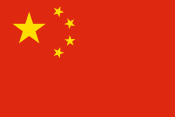 Zhengzhou, People's Republic of China
Zhengzhou, People's Republic of China St. Louis, United States
St. Louis, United States Stara Zagora, Bulgaria
Stara Zagora, Bulgaria Stuttgart, Germany
Stuttgart, Germany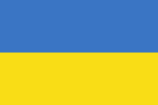 Dnipropetrovsk, Ukraine
Dnipropetrovsk, Ukraine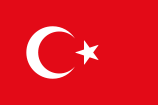 Denizli, Turkey
Denizli, Turkey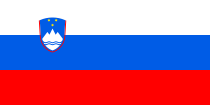 Koper, Slovenia
Koper, Slovenia
See also
- Samara flag
- Samara culture
References
- ↑ 1.0 1.1 Федеральная служба государственной статистики (Federal State Statistics Service) (2004-05-21). "Численность населения России, субъектов Российской Федерации в составе федеральных округов, районов, городских поселений, сельских населённых пунктов – районных центров и сельских населённых пунктов с населением 3 тысячи и более человек (Population of Russia, its federal districts, federal subjects, districts, urban localities, rural localities—administrative centers, and rural localities with population of over 3,000)" (in Russian). Всероссийская перепись населения 2002 года (All-Russia Population Census of 2002). Federal State Statistics Service. http://perepis2002.ru/ct/html/TOM_01_04_1.htm. Retrieved 2009-08-19.
- ↑ The value of density was calculated automatically by dividing the 2002 Census population by the area specified in the infobox. Please note that this value may not be accurate as the area specified in the infobox does not necessarily correspond to the area of the entity proper or is reported for the same year as the Census (2002).
- ↑ Правительство Российской Федерации. Постановление №170 от 19 марта 2010 г. «О применении на территории Самарской области времени второго часового пояса». Опубликован: "Российская Газета", №58, 22 марта 2010 г. (Government of the Russian Federation. Resolution #170 of March 19, 2010 On Using the Time of the Second Time Zone on the Territory of Samara Oblast. ).
- ↑ "Всесоюзная перепись населения 1989 г. Численность наличного населения союзных и автономных республик, автономных областей и округов, краёв, областей, районов, городских поселений и сёл-райцентров. (All Union Population Census of 1989. Present population of union and autonomous republics, autonomous oblasts and okrugs, krais, oblasts, districts, urban settlements, and villages serving as district administrative centers.)" (in Russian). Всесоюзная перепись населения 1989 года (All-Union Population Census of 1989). Demoscope Weekly (website of the Institute of Demographics of the State University—Higher School of Economics. 1989. http://demoscope.ru/weekly/ssp/rus89_reg.php. Retrieved 2007-12-13.
- ↑ 5.0 5.1 5.2 Home page | Home page | Samara City Administration
- ↑ Andrew Nagorski: The Greatest Battle, 2007, pp. 165-166
- ↑ See Internet site of the City of Samara
- ↑ ЦСКА (Москва) / О клубе
- ↑ http://www.rusbandy.ru/800content.html?PageID=336
- ↑ "Pogoda.ru.net" (in Russian). http://pogoda.ru.net/climate/28807.htm. Retrieved September 8, 2007.
External links
- Samara at the Open Directory Project
|
||||||||||||||
|
|||||||||||||||||||||||||||||||||||